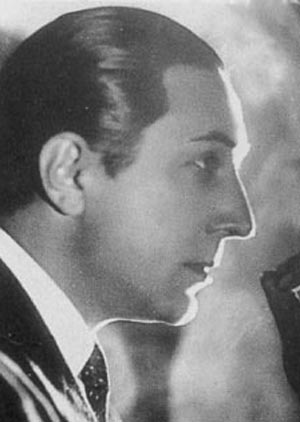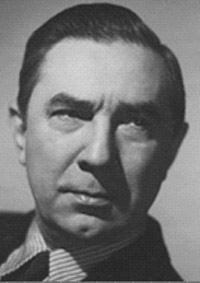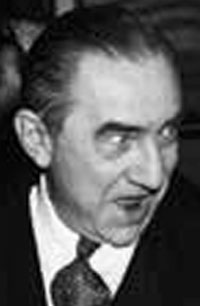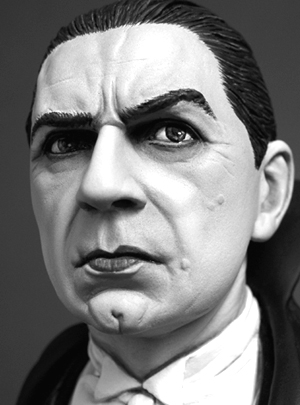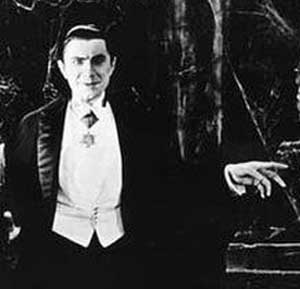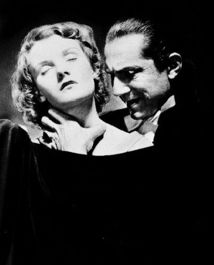Bela Lugosi
Copyright Michael D. Robbins 2005
Astro-Rayological
Interpretation & Charts
Quotes
Biography
Images and Physiognomic Interpretation
Bela Lugosi—Actor, Especially in Horror Films
October 20, 1882, Lugos, Romania, 3:30 PM, LMT. (Source Sabian Symbols, and Wynn’s Astrology wherein Wynn quotes Lugosi, April 1939, which states that the time was “from him”) Died (of a massive heart attack), August 16, 1956, Los Angeles, California.

(Ascendant, Pisces; MC, Sagittarius; Sun in Libra; Moon in Aquarius; Mercury and Mars in Scorpio; Venus in Sagittarius; Jupiter in Cancer; Saturn and Pluto conjunct in Taurus, with Neptune also in Taurus; Uranus in Virgo conjunct the DSC)
Twenty years on stage before a film career; best remembered for his horror roles in films Count Dracula (1931), The Raven (1935), The Night Monster (1942), and Frankenstein Meets the Wolf Man (!943). Allegedly a heroin addict; interested in occult study
to tell you the truth, I only like it then if I have a chance to look deep into their hearts and their minds.
In making theories, always keep a window open so that you can throw one out if necessary.
Birth Name:Bela Blasko
Profile: Actor
Birthdate: October 20, 1882
Date of Death:1956
Birthplace: Lugos, Hungary
Education:Budapest Academy of Theatrical Arts
________________________________________
The son of a banker, he trained for the stage at the Budapest Academy of Theatrical Arts. From 1901 he played lead parts on the Hungarian stage and from 1915 in films, sometimes using the name Arisztid Olt. In 1918, during the collapse of the Hungarian monarchy and the establishment of a Communist regime, he was active in politics and organized an actors' union. When the Leftists were defeated, in 1919, he fled to Germany, where he appeared in a number of films. In 1921 he emigrated to the US and began playing character parts on the stage and in films. His most notable success was in the title role of the stage presentation of Dracula, which he played for a year (1927) on Broadway and two years on the road. When he repeated the role in Tod Browning's 1931 screen version, introducing himself to film audiences with a heavy, deliberate, inimitable accent, "I - am - Dracu-la...," it was clear that the American screen had found itself a worthy aristocrat of evil.
During the 30s and early 40s, Lugosi shared with Boris Karloff the legacy of the silent screen's Lon Chaney. Technically, Lugosi might not have been as good an actor as Karloff, but he had a superior screen personality and as a personification of dark evil had no peer in Hollywood or elsewhere. Unfortunately, he was not choosy about his roles, and in addition to performing in the quality horror films at Universal and other major studios (and his only comic role, in Ninotchka, 1939) which made him famous, he appeared indiscriminately in scores of infantile films in which he was given the most ludicrous lines.
On the screen, Lugosi portrayed mad scientists and demented megalomaniacs who evoked no pity or compassion in audiences. But his personal life had its pathetic quality. At first under pressure from studio publicity, and later on his own accord, he allowed the Vampire image to become part of his real life. He began giving interviews while lying in a coffin, was once seen at a Hollywood premiere accompanied by a gorilla, and in his later films played parodies of himself. Besides, he was almost always involved in money or marital problems. In 1955 he had himself committed to the California State Hospital as a drug addict. He then returned briefly to the screen and even announced plans for a fourth marriage, but in August of 1956 he died. He was buried with his Dracula cape.October 20, 1882
Date of Death: August 16, 1956
Bela Lugosi was the stage name of Blaskó Béla Ferenc Dezso (October 20, 1882–August 16, 1956).
He was born in Lugos, Transylvania, Austria-Hungary (now Lugoj, Romania), the youngest of four children of a banker.
Lugosi started his acting career on the stage in Europe in several Shakespearean plays. He however, became most notably known for his portrayal of Dracula in a stage production of Bram Stoker's classic vampire story.
During World War I he served as an infantry lieutenant for the Central Powers.
He left from his native Hungary for Germany in 1919 after persecution following his complicity in the forming of an actor's union, and emigrated to the United States in 1921.
He was most famous for his title role in Tod Browning's Dracula (1931) (building on the stage role). The film was a success, but Lugosi was typecast as a horror heavy with such movies as White Zombie and Scared to Death. Later on, the acting jobs dried up and he became addicted to morphine.
Late in his life, he again got to star in movies, albeit lousy ones. Ed Wood, a long-time fan of Lugosi's, offered him numerous roles in his films, always playing some variant of a mad scientist/vampire type, even in movies in which such a role made no sense — such as Glen or Glenda. The biographical film Ed Wood, by Tim Burton, portrayed Wood's relationship with Lugosi, who was played by Martin Landau.
He died of a heart attack, aged 73, in Los Angeles, California.
One of Lugosi's most infamous roles was in a movie that was released after he was dead. Ed Wood's Plan 9 from Outer Space featured footage of Lugosi — who died during filming — interspersed with a double who looked nothing like him, and Lugosi got top billing for the movie.
He was also the subject of a song by gothic rock band Bauhaus entitled Bela Lugosi's Dead.
Truth being stranger than fiction sometimes, Bela Lugosi was buried in his full Dracula costume, as per the request in his will, in the Holy Cross Cemetery in Culver City, California.Bela Lugosi was born Béla Ferenc Deszö Blaskó on October 20, 1882, in Lugos, Hungary. He was the son of a banker, Istvan, who kept a strict house. Bela ran away to the city of Resita at the age of eleven, never returning again to his hometown. There, he worked as a miner for a few years, but eventually began work in the theatre. He was given bit parts in plays, but was laughed off the stage most of the time.
He moved to Szadbadka, where he found his sister Vilma and his mother, who told him his father had died after losing the family savings. He entered school again in 1898, but stayed for only four months. It was back to the theatres for Bela.
After working on the railroad for some time, he joined a theatre company, and was adored by audiences. He was accepted into the Academy of Performing Arts, and it was during this period that he adopted the name "Lugosi." He began to play larger roles in larger plays, and he was eventually the top-billing member of the theater group.
In 1914, he enlisted in the Hungarian army. He was discharged in 1916 after convincing officials that he was "mentally unstable." Not soon after, he was married to Ilona Szmik on June 25, 1917. It was also during this time that he began appearing in movies. His first picture was A Leopárd, in which he played the lead role.
He was part of a Communist regime after the war, and as a result was placed on an arrest list of people who were also part of the group. He fled to Vienna in 1919, and soon after to Germany. He played parts in several German films, including Sklaven Fremedes Willens (1919) and Der Januskopf (1920). A little while later, Bela received a telegram from his wife Ilona. She had divorced him.
He emigrated to the United States of America in December of 1920. He wasted no time in falling in love with, marrying, and divorcing an actress named Ilona von Montágh. His first American film was 1923's The Silent Command, a suspenseful spy movie in which Bela played the bad guy. He officially became a US citizen on June 26, 1931.
He took on the role of Count Dracula in Horace Liveright's play in place of actor Raymond Huntley in 1929. It played for 33 weeks on Broadway, and also toured the entire West Coast. Soon after, the rights to play were picked up by Universal Studios. Universal wanted Lon Chaney, Sr. to play the lead role, but Chaney died of throat cancer in 1930. It wasn't until after Chaney's death that Bela was even considered for the part of Count Dracula. On July 27, 1929, Bela married Beatrice Woodruff Weeks. On July 30, 1929 Bela divorced Beatrice Woodruff Weeks. Weeks blamed Clara Bow, who Lugosi had had a brief love affair with a year earlier, for the breakup.
After much consideration and nagging (on the part of Bela), Lugosi was given the lead part in Dracula. He was paid a total of $3500, a fraction of what second-billed David Manners received. He skipped on the part of the monster in Universal's film version of Frankenstein, a decision which many think was his greatest mistake ever.
During the years after his role in Dracula, he appeared in many B-movies, some being above-average films and some being pathetic wastes of celluloid. Some highlights from this period in Bela's life include 1932's White Zombie, 1935's The Black Cat, Mark of the Vampire and The Raven. He married the 20 year-old Lillian Arch in January of 1931, this fourth marriage lasting 20 years. Bela Lugosi, Jr. was born on January 5th, 1938.
During the late thirties and througout the forties, Bela had a lot of trouble finding work. What little work he did find paid next to nothing and he was not sure how he would support his family. He and Lillian seperated for a while in August 1944, and finally divorced in 1951.
In the mid-fifties, Bela met up with a young writer-director-producer-actor named Edward D. Wood, Jr. Bela appeared in several of Wood's films, playing the lead only once, in 1955's Bride of the Monster as Dr. Eric Vornoff. The other two were Glen or Glenda? in 1953, and, after his death, in Plan 9 From Outer Space, the so-called "worst film of all time", in which Bela's scenes were taken from footage he and Wood shot for reasons currently unknown (some say it was for a film called The Ghoul Goes West, but none of the footage matches anything in Wood's script). The rest of his scenes were played by Wood's wife's chiropractor whose face was conveniently covered by a cape the entire time.
Bela had himself commited to the Los Angeles County General Hospital in April of 1955 to help him recover from a morphine addiction. He had been taking the drug for quite some time to ease shooting pains, as Bela put them, in his legs. He was released on August 3rd later that year, after passing an examination.
Not long after his release, he married Hope Lininger, a fan who had written him letters every for single day he was in hospital. She would be his fifth and final wife. Bela died at the age of 73, on August 16, 1956.Bela Lugosi, Actor
• Born: 20 October 1882
• Birthplace: Lugos, Hungary (now Romania)
• Death: 16 August 1956
• Best Known As: Star of the 1931 movie Dracula
Name at birth: Béla Ferenc Dezso Blasko
Bela Lugosi shot to stardom in the title role of the 1931 film version of Bram Stoker's Dracula and set the standard for movie vampires. A successful stage actor in his native Hungary and in Germany, he emigrated to the United States in the 1920s and played various character roles until grabbing the lead in the stage production of Dracula in 1927. Lugosi's talent for playing a villain led to a career of playing monsters and mad scientists, and it's generally accepted that he made a lot of bad choices. Some of his more memorable movies include The Black Cat (1934), Ninotchka (1939, starring Greta Garbo), The Wolfman (1941) and Abbot and Costello Meet Frankenstein (1948). In 1955 Lugosi committed himself to an institution, admitting an addiction to methadone. In his last years his personal life and career were on the skids, but he still worked a little in television and low-budget films. He died while working on what has been called one of the worst movies ever made, Plan 9 From Outer Space (released in 1959).
